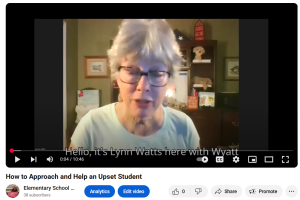Calm in the Chaos: Strategies for Supporting an Upset Student
Whether it’s a playground conflict, academic frustration, or something happening at home, elementary students can get upset for many reasons—and those emotions often show up suddenly and intensely. As a school counselor, your approach in those fragile moments can make all the difference. With the right strategies, you can build trust, de-escalate big feelings, and guide students toward emotional regulation and problem-solving.
Effective Strategies for Approaching and Helping an Upset Student
1. Stay Calm and Grounded Yourself
Why it works: Children mirror the emotional tone of adults. If you’re calm, you create a safe emotional space.
How to do it: Breathe deeply, speak in a soft tone, keep your body language open and relaxed.
2. Use a Soft Opening: Offer Presence, Not Pressure
Why it works: Some students need time before they’re ready to talk. Offering quiet support helps them feel seen without feeling overwhelmed.
Try saying:
-
“I’m here when you’re ready.”
-
“Would you like to sit with me for a minute?”
-
“Would it help to take a break together?”
3. Name the Feeling
Why it works: Helping students identify and label emotions builds emotional literacy and can reduce intensity.
Try saying:
-
“It looks like you might be feeling really frustrated.”
-
“You seem sad right now. Do you want to talk about it?”
4. Use Grounding Techniques
Why it works: When emotions are high, grounding helps bring students back to the present moment.
Examples:
-
5-4-3-2-1 (Name 5 things you can see, 4 things you can touch…)
-
Breathing exercises: Try “Box Breathing, breathe in 4 counts, hold 4 counts, breathe out 4 counts, and hold 4 counts, repeat”
-
Squeeze a stress ball or sensory item
5. Offer Choices
Why it works: Upset students often feel out of control. Giving small choices restores a sense of power and agency.
Try saying:
-
“Would you like to draw or talk right now?”
-
“Do you want to stay here or go for a short walk?”
6. Validate, Don’t Minimize
Why it works: Validation helps students feel understood, which opens the door to connection.
Try saying:
-
“That sounds really hard.”
-
“It makes sense that you’re upset.”
7. Know When to Give Space vs. Step In
Why it works: Some students regulate best with a bit of space; others need immediate co-regulation. Watch body language and listen for cues.
Tip: Have a “calm corner” or “take-a-break” space where students can choose to go.
What Not to Do—and Why
1. Don’t Say “Calm Down”
Why not? This often feels invalidating and dismissive. Students may feel misunderstood or shut down further.
2. Don’t Demand an Explanation Immediately
Why not? When a student is dysregulated, they may not be able to verbalize what’s wrong. Pushing for answers too soon increases stress.
3. Don’t Shame or Embarrass
Why not? Comments like “You’re too old for this” or “Everyone’s looking at you” undermine trust and may escalate the situation.
4. Don’t Overreact or Take It Personally
Why not? Students may act out emotionally in the safest environment they know. Stay grounded and focus on the “why behind the behavior.”
Final Thoughts:
Helping an upset student isn’t about fixing the problem immediately—it’s about showing up with empathy, patience, and the right tools. Your steady presence and calm approach can help a child begin to feel safe, understood, and eventually empowered to cope. Then don’t forget to follow-up and teach coping strategies for the future.

